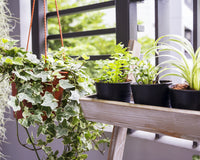Gardening isn’t just for the rural communities that can benefit from expansive land to cultivate. Urban gardeners have come up with their own ideas to grow life amidst the concrete jungle. Here are some tips to get you started on your own urban garden:
Plan Your Garden
Where are you going to place your garden? If you have a sunny window, preferably a south-facing one, most plants will like sitting next to it. Balconies and rooftops are great too. Just make sure there’s plenty of sunlight. For shadier spots, you can choose shade-loving plants.
Choose Containers
Container gardens are perfect for small spaces. You have loads of choices when it comes to size and shape; choose something that won’t overcrowd your living space. You can also recycle tin cans, storage boxes, shoes, and crates to make beautiful planters.
Select Plants
Know your growing zone before selecting plants. Pick varieties that are suited to your region so they can thrive with little effort. Other than that, choose varieties that won’t require much maintenance and can easily adapt to the indoor environment. Coneflower, hens and chicks, zinnias, and daylilies are good options.
Shallow-rooted Vegetables
If you’re growing edibles, go for the shallow-rooted varieties. Herbs, lettuce, spinach, radishes, and kale have shallow roots and will grow well in small pots.
Good Drainage
Whether you purchase containers or recycle discarded material from home, make sure there are drainage holes at the bottom. If the holes aren’t large enough for excess water to drain out easily from the container, you’ll need to drill them before planting in them.
Choose Good Soil
Don’t use garden soil to fill the pots since it becomes compacted and doesn’t drain well. It also brings weeds into your urban garden. Instead, use a good quality packaged potting mix to fill the containers.
Take It Up!
To use small spaces to their full potential, go for vertical gardening. Stack planters, vertical wall planters, and wall pockets are ideal options to grow your plants vertically. You can also choose vining plants, like cucumbers and tomatoes, and install trellises to help them grow vertically.
Hanging Baskets
Flowers look beautiful in hanging baskets! Have some hanging baskets to adorn entrances, porch, or wherever you find fitting. But do make sure it's accessible, and you can water it easily without climbing a ladder each time. Taking them down to water them can also be tiring, so adjust them to a good height accordingly.
Plants for Shady Spots
While you’ll find plenty of options for your sunny spaces, shady spots shouldn’t go barren either. Some plants can tolerate shade. Ferns, copper plant, begonia, and garden hydrangea will do well in spaces with little sunlight.
Water Right
Container gardens need more frequent waterings than in-ground ones. You’ll probably need to water once or twice each day in peak summers. But don’t overwater. Waterlogged soil can promote root rot. Make sure you discard any excess water that drains out from the containers into the saucer underneath.
Fertilize
Offer a diluted dose of water-soluble fertilizer once a month to keep your plants healthy. Alternatively, use slow-release granular fertilizers to keep your plants nourished for several months.
Have Lots of Fun
At the end of the day, gardening isn’t just about sustainability or adorning your space. Once you start growing plants, you’ll also experience the satisfaction that comes with them. It relieves stress, brings you closer to nature, and is a great learning activity that kids will love getting involved in.




